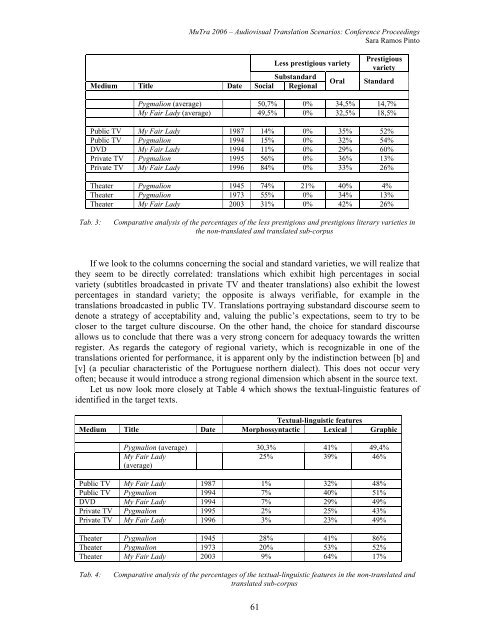Proceedings - Translation Concepts
Proceedings - Translation Concepts
Proceedings - Translation Concepts
You also want an ePaper? Increase the reach of your titles
YUMPU automatically turns print PDFs into web optimized ePapers that Google loves.
MuTra 2006 – Audiovisual <strong>Translation</strong> Scenarios: Conference <strong>Proceedings</strong><br />
Sara Ramos Pinto<br />
Less prestigious variety<br />
Substandard<br />
Medium Title Date Social Regional<br />
Oral<br />
Prestigious<br />
variety<br />
Standard<br />
Pygmalion (average) 50,7% 0% 34,5% 14,7%<br />
My Fair Lady (average) 49,5% 0% 32,5% 18,5%<br />
Public TV My Fair Lady 1987 14% 0% 35% 52%<br />
Public TV Pygmalion 1994 15% 0% 32% 54%<br />
DVD My Fair Lady 1994 11% 0% 29% 60%<br />
Private TV Pygmalion 1995 56% 0% 36% 13%<br />
Private TV My Fair Lady 1996 84% 0% 33% 26%<br />
Theater Pygmalion 1945 74% 21% 40% 4%<br />
Theater Pygmalion 1973 55% 0% 34% 13%<br />
Theater My Fair Lady 2003 31% 0% 42% 26%<br />
Tab. 3:<br />
Comparative analysis of the percentages of the less prestigious and prestigious literary varieties in<br />
the non-translated and translated sub-corpus<br />
If we look to the columns concerning the social and standard varieties, we will realize that<br />
they seem to be directly correlated: translations which exhibit high percentages in social<br />
variety (subtitles broadcasted in private TV and theater translations) also exhibit the lowest<br />
percentages in standard variety; the opposite is always verifiable, for example in the<br />
translations broadcasted in public TV. <strong>Translation</strong>s portraying substandard discourse seem to<br />
denote a strategy of acceptability and, valuing the public’s expectations, seem to try to be<br />
closer to the target culture discourse. On the other hand, the choice for standard discourse<br />
allows us to conclude that there was a very strong concern for adequacy towards the written<br />
register. As regards the category of regional variety, which is recognizable in one of the<br />
translations oriented for performance, it is apparent only by the indistinction between [b] and<br />
[v] (a peculiar characteristic of the Portuguese northern dialect). This does not occur very<br />
often; because it would introduce a strong regional dimension which absent in the source text.<br />
Let us now look more closely at Table 4 which shows the textual-linguistic features of<br />
identified in the target texts.<br />
Textual-linguistic features<br />
Medium Title Date Morphossyntactic Lexical Graphic<br />
Pygmalion (average) 30,3% 41% 49,4%<br />
My Fair Lady<br />
25% 39% 46%<br />
(average)<br />
Public TV My Fair Lady 1987 1% 32% 48%<br />
Public TV Pygmalion 1994 7% 40% 51%<br />
DVD My Fair Lady 1994 7% 29% 49%<br />
Private TV Pygmalion 1995 2% 25% 43%<br />
Private TV My Fair Lady 1996 3% 23% 49%<br />
Theater Pygmalion 1945 28% 41% 86%<br />
Theater Pygmalion 1973 20% 53% 52%<br />
Theater My Fair Lady 2003 9% 64% 17%<br />
Tab. 4:<br />
Comparative analysis of the percentages of the textual-linguistic features in the non-translated and<br />
translated sub-corpus<br />
61
















